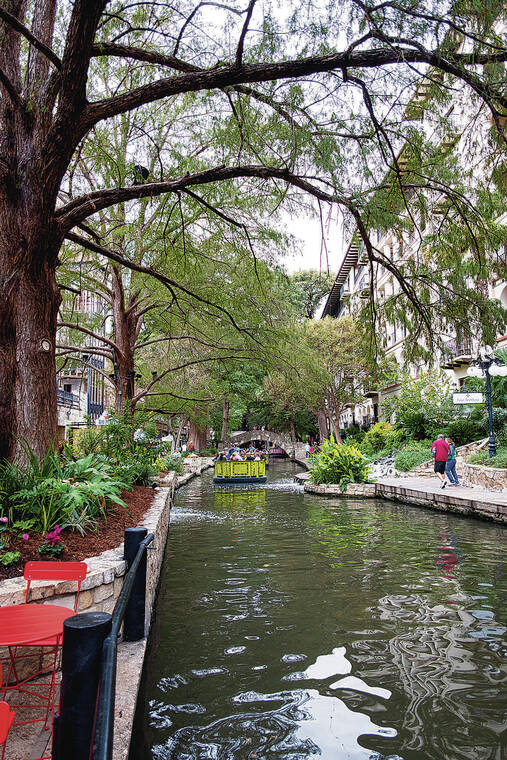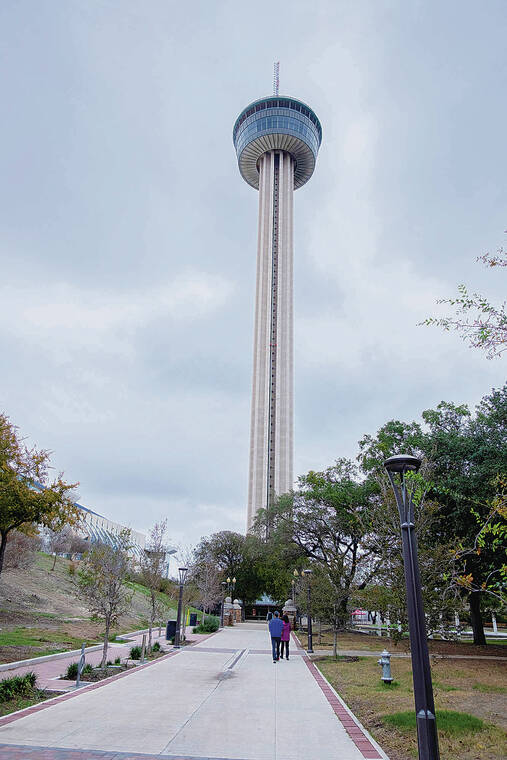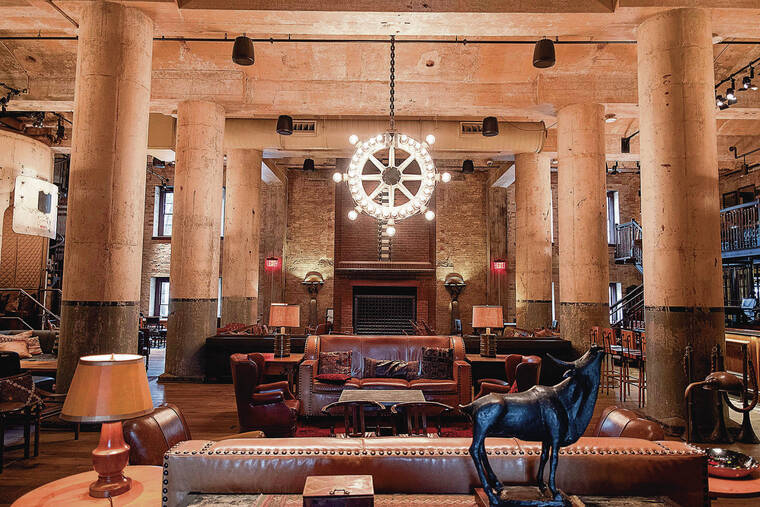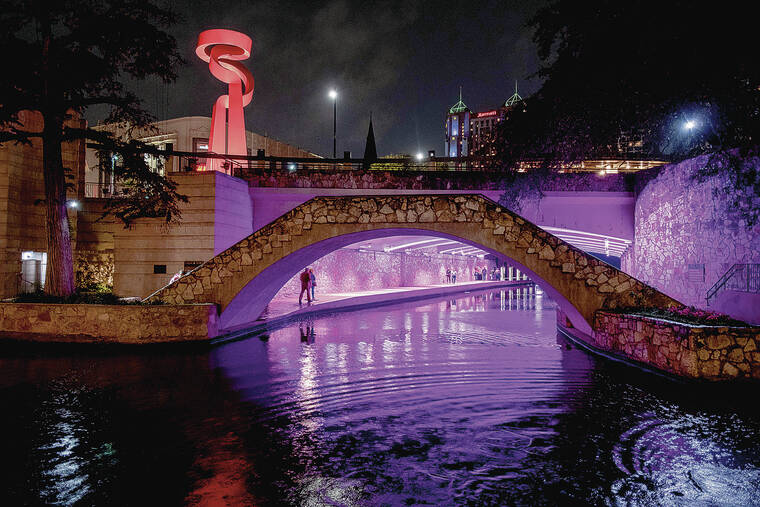San Antonio blends simple pleasures with a rich history

TRIBUNE NEWS SERVICE
The San Antonio River Walk is considered the No. 1 attraction in Texas.

TRIBUNE NEWS SERVICE
At 750 feet, Tower of the Americas offers the best views of San Antonio.

TRIBUNE NEWS SERVICE
Hotel Emma lures with a style of industrial-meets-smokeasy.

TRIBUNE NEWS SERVICE
San Antonio River Walk aglow year round.




It was Nov. 5 when the switch from daylight saving time hit us with its annual reminder that the world can be a dark place. Not only was it creeping night into our day, but it introduced rain as if a switch had been flipped to turn off the sun.
My husband, Benjamin, and I were tired, both mentally and physically, from running three businesses out of our home. And so, we took advantage of Veterans Day weekend by booking a flight and running to the unknown.
In this case, it was San Antonio, Texas.
Neither of us had ever been, nor had we visited Texas in decades. When we first started dating, we learned our parents attended the same college in Dallas. Ironically, we “knew” each other as toddlers and spent the next 30 years following one another around the world from Washington and Germany to Spain and California.
Now married and nomadic, we would be returning to the Lone Star State as a drained duo looking for food, culture and, above all, a place to rest.
Hotel Emma delivered, especially on the last part, with a king bed, Frette linens and black-out curtains that defied jet lag. Yet it was the lobby that had me creating Instagram stories at check-in, lured by the industrial-meets-Texas-smokeasy style. Leather chesterfields and fireplace nooks dotted the warehouse-esqe foyer where towering machinery replaced bouquets on mahogany tables.
Don't miss out on what's happening!
Stay in touch with breaking news, as it happens, conveniently in your email inbox. It's FREE!
Back in 1894, the landmark property made its debut as Pearl’s Brewhouse, designed by Chicago architect August Maritzen. As San Antonio’s only brewery to survive Prohibition, the Pearl resurrected as “Emma” in 2015 after a 14-year closure.
Despite the passing of time, Maritzen’s blueprints are still trending, with the riverfront hotel serving as the flagship for Pearl’s culinary and cultural hub. The city has Pace Picante Sauce to thank for that … well, sort of. In 1994, Christopher “Kit” Goldsbury, sold Pace Foods to Campbell Soup Co. for over $1 billion in cash. Among other things, Goldsbury invested his fortune back into his hometown of San Antonio with the development of the Pearl.
After margaritas in the hotel library, we explored the historic San Antonio River Walk in downtown.
As the leading attraction in Texas, the urban river was the brainchild of Robert H.H. Hugman, an architect who envisioned winding pathways skirting the channel. Not only would it navigate heavy rains, but it would serve as a pedestrian zone lined with shops and restaurants. Hugman’s proposal dating back to 1929 came to fruition, now drawing its biggest crowd during the holidays when 100,000 Christmas lights illuminate the River Walk.
For now, we would settle for that year-round florescent glow of purple, blue, green and pink that bounced off the water, reflecting images of Parisian bridges and rainbow umbrellas. The scent of brewing storms and beef brisket took us to Smoke restaurant where we ordered Texas barbecue, baked beans and mac and cheese.
After dinner, we hopped aboard Go Rio’s 35-minute San Antonio River Walk boat tour. Speaking over a microphone to beer-cozied passengers, our guide pointed out highlights along the 15-mile River Walk that connects Brackenridge Park to five Spanish missions.
Established in 1718 as Mission San Antonio de Valero, the Alamo fortress is where the Battle of the Alamo ended in 1836 with Mexico conquering Texas. Nearly 200 Texans were killed in their fight for independence, including Davy Crockett, making the 13-day battle a turning point in the Texas Revolution.
There was plenty of history to experience including the Spanish-mission complex, the Alamo Church, the living-history encampment and the Alamo Exhibit in the new Ralston Family Collections Center housing hundreds of artifacts — many of which were donated by musician Phil Collins.
The Alamo, Mission Concepcion, Mission San Jose, Mission San Juan and Mission Espada comprise San Antonio’s five missions — four of which are protected and preserved by San Antonio Missions National Historical Park.
In 2015, the park’s collection of Spanish Colonial architecture earned it the title as a UNESCO World Heritage Site, the first and only in Texas. Perhaps it was the rain or the darkness of the sky, but the missions felt somber and sacred, as if the walls wanted to cry out with stories of the Indigenous people from 300 years ago.
With its rich history alone, you could easily spend a day at the park, and many do. Bikes are available for rent at the visitor center, meaning you can pedal your way from mission-to-mission (via River Foundation Project, Confluence Park) along the 15-mile San Antonio River Walk Trail.
We Ubered.
One, because it was raining and, two, because we wanted to eat. And eat we did, this time at Silo Prime. Located at the Fairmount Hotel, the property made international news — and the Guinness World Record — in 1985 when it was lifted onto rollers and moved five blocks to its current location. Saved from demolition, the 1906 Fairmount is still one of the grandest structures in the city.
But it was the steakhouse inside that wooed us with its dim lighting, live piano and a menu by Chef Gary Boatman. From the open kitchen, flames were flying and skillets were flipping, leaving us with choices like barbecue shrimp, Texas quail and 14-ounce rib-eye.
After dinner, we headed back to Hotel Emma so we could rise early for the day ahead. But first, coffee.
The nearby Creme awakened our minds, teasing San Antonio on the brink of a boom. This emerging city had already grabbed our attention with the Pearl, and now even more so when we learned of The Creamery district. Dating to 1938, this former Borden Dairy facility is slated to be a mixed-use neighborhood with offices, restaurants, shops and apartments to work, play and live. For now, the Parisian-inspired Creme was the test project that had passed with flying colors; the place was packed with patrons who appeared to have the freedom to work, or not.
We headed to San Antonio Museum of Art for our nonworking getaway. Spanning 5,000 years, the impressive art collection is housed in the former Lone Star Brewery. SAMA has the largest collection of Greek, Roman and Egyptian art in the southern U.S., as well as works from Korea, India, Japan, China and the Americas.
That afternoon was spent getting lost in the right direction; first with a walk through Hemisfair Park, followed by a trip up the 750-foot Tower of the Americas. This 1968 World’s Fair site is being redeveloped into a walkable green-space neighborhood. From the observation deck, we pointed out landmarks to see just how far we had come, and where we had yet to go.
That evening, the sky opened, and the rain poured. For us, it didn’t matter. We had the best spot in the house at Camp Hot Wells. On the south side of town, this bathhouse has sulfur-spring-fed soaking tubs. Drinks and nibbles can be delivered at the push of a button, but we saved our charcuterie appetites for Cured.
Helmed by six-time James Beard Foundation Award Finalist Chef Steve McHugh, Cured greets you with penny-tile floors and a charcuterie case of signature meats. The tin ceiling and bistro chairs set the stage for hand-crafted, farmhouse dishes that are made in house.
Chorizo, pork belly, tuna — about a dozen types of cured meats grace the charcuterie list, as well as local cheeses which we tried and loved. Needless to say, we went out with a bang, adding Cured as one of favorite restaurants of all time.
Before our flight home, I swam laps in the pool while Benjamin explored the weekly farmers market at the Pearl. Clinging to the edge, I gazed up the brick wall of the 19th century brewhouse-turned-hotel.
I thought about Goldsbury and the Pearl, where all could shine in the present under the spotlight of the past. I thought about our cocktails at Emma “paid” with wooden nickels and the noble integrity of architects gone before. I thought about the limestone walls of the Alamo and the privilege of walking in the steps of heroes. I thought about how the second biggest city in Texas had the power to win me over with a wink of small-town charm.
I guess sometimes you just need to run away to the unknown to find a “peace” of home.



